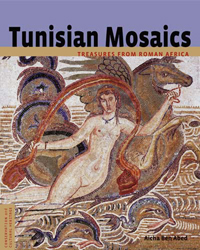
Aïcha Ben Abed; 2006
Purchase a Copy
Find in WorldCat
As the Roman Empire expanded its African settlements in the early centuries of the common era, thousands of mosaic floor pavements were fashioned to adorn the townhouses and rural estates of the African upper classes. Between the second and sixth centuries, mosaic art blossomed, particularly in Africa Proconsularis, the region comprising modern Tunisia. In contrast to the official art of imperial Rome, mosaics generally expressed the worldviews of private citizens. These artworks are remarkable for the intricate beauty of their polychromatic geometric and floral designs, as well as for figural scenes depicting the interests and activities of the patrons who commissioned them—scenes of daily life, athletic contests, gladiator spectacles, and classical literature and mythology.
Abundantly illustrated throughout, Tunisian Mosaics: Treasures from Roman Africa offers the general reader a lively introduction to this extraordinary ancient art. Initial chapters survey the historical background of Roman Africa and discuss the development of mosaic art in the Mediterranean. Subsequent chapters profile Tunisia's major mosaic sites and tour the collections of important museums. A final chapter surveys current initiatives to preserve this heritage for future generations.
Aïcha Ben Abed, director of monuments and sites at the Institut National du Patrimoine, in Tunis, is one of the world's leading experts on the mosaics of Roman Africa.
Related Getty Conservation Institute projects: MOSAIKON and Conservation of Mosaics in Situ.


